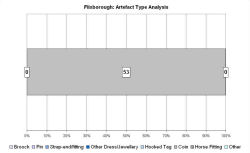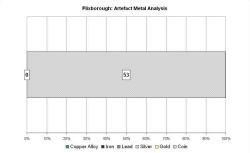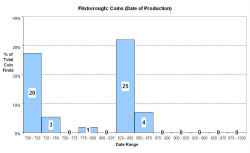Fingerprint charts for i) artefact date analysis, ii) artefact type analysis, iii) artefact metal analysis and iv) coins – date of production




References: Blackburn 1993; Loveluck 1998; Loveluck 2001;
Loveluck 2007; Loveluck and Atkinson 2007
Archives:
http://ads.ahds.ac.uk/catalogue/search/fr.cfm?rcn=NMR_NATINV-61128
The Middle and Late Saxon settlement at Flixborough is situated on windblown sand 8km south of the Humber estuary, adjacent to the former settlement of North Conesby, and overlooking the floodplain of the River Trent. Excavations between 1989-91 uncovered the remains of buildings over 40m in length and other structures, and large quantities of artefacts (c. 15,000) were recovered as a result of the survival of large midden deposits. Between 1991-5, further geophysical survey and field-walking demonstrated that Middle and Late Saxon settlement evidence extended north and south of the excavated site. There seems to have been general continuity in the use of space, with buildings located on two sand spurs and also, intermittently, within the terminus of the shallow valley that lay between them.
Although it was initially interpreted as an early minster site, the final report (Loveluck 2007) concludes that the assemblages from the late 7th to early 9th centuries indicate the aristocratic lifestyle of a secular rural estate centre, although an ecclesiastical focus or building may have existed such as a mortuary chapel, associated with burial. The artefacts from the Middle Saxon period are those associated with the lordly pursuits of hunting and feasting, including imported continental glass vessels.
There was a major change in the nature of activities in the early to mid-9th century. The presence of styli and inscribed artefacts indicates a literate element within the population, and there is an increase in the scale of craft activity, perhaps indicating that a monastic community had been established by this phase. There is a return to artistocratic display in the 10th century, with conspicuous consumption of timber and other resources from the local estate. This seems to reflect the secularisation of an ecclesiastical estate centre or small monastery as it was transformed into the manorial centre of North Conesby.
Unfortunately, the finds report only became available at the end of the VASLE project so the dataset is based only on the coin records held in the EMC. Despite the large number of coins recovered from Flixborough, Loveluck argues that, when set against the overall numbers of objects recovered, they are 'unlikely to reflect the existence of a market or site of exchange at Flixborough itself' (Loveluck 2007, 128).
Fingerprint charts for i) artefact date analysis, ii) artefact type analysis, iii) artefact metal analysis and iv) coins – date of production




© Internet Archaeology/Author(s)
URL: http://intarch.ac.uk/journal/issue25/2/4.4.24.html
Last updated: Tues Apr 21 2009